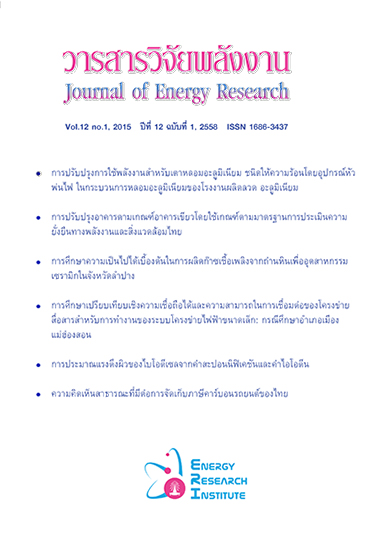การปรับปรุงการใช้พลังงานสำหรับเตาหลอมอะลูมิเนียม ชนิดให้ความร้อนโดยอุปกรณ์หัวพ่นไฟ ในกระบวนการหลอมอะลูมิเนียมของโรงงานผลิตลวด อะลูมิเนียม
Main Article Content
บทคัดย่อ
อุตสาหกรรมหลอมโลหะเป็นอุตสาหกรรมประเภทหนึ่งที่มีการใช้พลังงานอย่างสูงและมีศักยภาพในการลดการใช้พลังงานสูงเช่นกัน ความร้อนสูญเสียในอุตสาหกรรมหลอมโลหะ ได้แก่ ความร้อนสูญเสียไปกับไอเสีย, ความร้อนสูญเสียผ่านผนังเตาหลอม, ความร้อนสูญเสียจากการเผาไหม้ไม่สมบูรณ์, ความร้อนสูญเสียผ่านช่องเปิด เป็นต้น สำหรับ สารนิพนธ์ฉบับนี้เป็นการศึกษาเพื่อปรับปรุงการใช้พลังงานสำหรับเตาหลอมอะลูมิเนียม โดยการลดความร้อนสูญเสียผ่านผนังเตาหลอมและลดความร้อนสูญเสียผ่านช่องเปิด อันเกิดจากความเสื่อมสภาพของวัสดุทนความร้อนของตัวเตาหลอม ซึ่งผู้ใช้งานส่วนใหญ่มองข้ามถึงปัญหาด้านนี้ เนื่องจากใช้งบประมาณสูงในการเปลี่ยนวัสดุทนความร้อน
การศึกษาครั้งนี้ ทำการเก็บข้อมูลอุณหภูมิด้านการผลิต อุณหภูมิจุดต่าง ๆ ของเตาหลอม และวิเคราะห์ความร้อนสูญเสียที่เกิดขึ้น รวมถึงประสิทธิภาพเชิงความร้อนของเตาหลอมในปัจจุบัน ซึ่งพบว่า ประสิทธิภาพเชิงความร้อนอยู่ที่ 39.61% และหากเปลี่ยนวัสดุทนความร้อนใหม่จะทำให้ประสิทธิภาพเชิงความร้อนปรับปรุงขึ้นเป็น 43.27% โดยสามารถลดค่าใช้จ่ายด้านพลังงานได้ถึง 2 ล้านบาทต่อปี จากงบประมาณลงทุน 6.63 ล้านบาท อายุโครงการ 10 ปี ผลตอบแทนจากการลงทุนตลอดโครงการ คือ NPV ที่ อัตราส่วนลด 12% และ IRR เป็น 4.21 ล้านบาทและ 27.67% ตามลำดับ
Enerygy improvement of aluminum melting furnace employing bunker oil burner type
Kosit Pugasab1 and Witthaya Yongcharoen2
1Energy Technology and Management, Graduate School – Interdisciplinary Program. Chulalongkorn University.
2Department of Mechanical Engineering, Faculty of Engineering. Chulalongkorn University.
Metal industry is one of the most intensive energy consumption with highly potential to reduce the energy consumption. The objective of this study aims to improve energy consumption of Aluminum furnace using bunker oil type burner. Presently, there is abundant of heat loss from the furnace via the 700°C flue gas or through the walls with deteriorate refractory materials which is required high investment to improve.
This study included the collecting of process parameters and the recording of operating temperatures of related points such as wall temperatures and bath temperatures. These data were then calculated to determine the heat loss and the efficiency of the furnace. It was found that the efficiency of the existing furnace was 39.61%. If refractory materials were renewed, the efficiency of the furnace would be improved to 43.27%. 85,500 liters of bunker oil consumption would be reduced, hence the energy cost reduction of 2 million Baht per year. With 6.63 million Baht investment for renewing refractory materials, simplified NPV with discount rate of 12% and IRR will be 4.21 million Baht and 27.67%, respectively, through the project life 10 years.

